What’s in Your Shed? visits Oxon farmer Harry Metcalfe
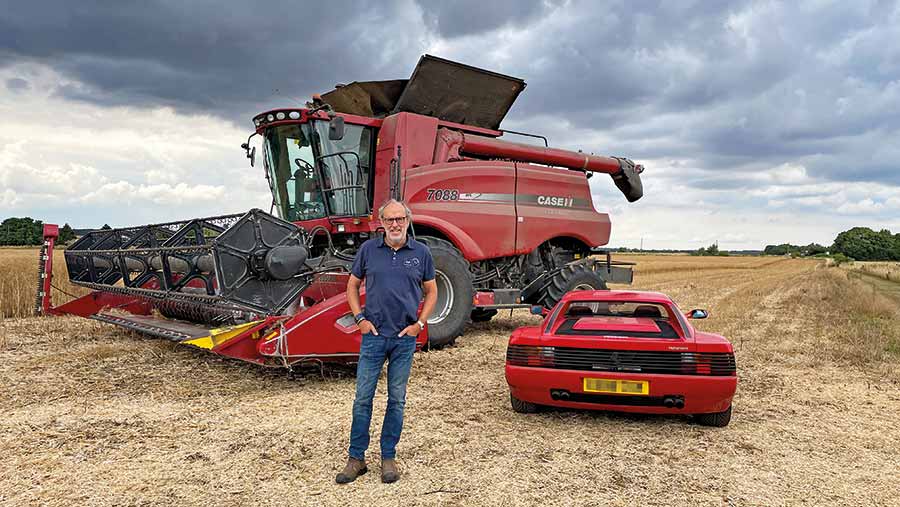 Harry Metcalfe with his Case IH Axial Flow 7088 with 24ft header, and a Ferrari Testarossa © James Andrews
Harry Metcalfe with his Case IH Axial Flow 7088 with 24ft header, and a Ferrari Testarossa © James Andrews Motoring journalist, YouTuber and farmer Harry Metcalfe is the latest to feature in our What’s in Your Shed? series.
But forget the shiny sport cars – the Ferraris, the Porsches and the Jags lining Harry’s Garage, we’re in his shed with the proper (farming) kit.
See also: First impressions: New cab revitalises Case IH Optum tractor
Farm facts
- Size 160ha
- Arable area 110ha
- Organic grass 40ha
- Crops grown Wheat, barley, oilseed rape, linseed
- Staff Harry and his son Charlie Metcalfe, plus contractor John Walker
How did you get into farming?
As a kid I loved farming and, after studying for an HND at Shuttleworth Agricultural College, I started working as grain buyer in the Home Counties.
It was a great job, but I had a mission to be a farmer. After a brief spell selling lime, I came up with a plan to become a self-employed grain buyer and lime seller so that I would have time to farm on the side.
I took on a few patches of grassland in Hertfordshire and started buying ewes with lambs at foot to fatten up, keeping back the female lambs to breed from.
It soon became clear that sheep were too time consuming to work alongside the day job, so I turned my attention to arable farming.
In the shed
- Tractors 2018 Case IH Puma 150 and 1988 Renault 85TS 4WD
- Combine 2009 Case IH Axial Flow 7088 with 24ft header
- Telehandler 2004 Manitou MLT 741-120 LSU
- Cultivation kit 7.5m Claydon Straw Harrow, 5m Vaderstad Carrier, 12m Twose Cambridge rolls
- Other Fraser grain trailer, trailed fuel bowser, Suton sweeper brush, Cherry Products grain pusher
My first proper opportunity came when one of the farmers I was dealing with fancied a break and gave me the chance to farm his land for a year.
He never asked for it back, and when other landowners did the same, I eventually found myself farming about 2,000 acres (800ha).
I had some of my own kit, including a JCB Fastrac and demount Airtec sprayer, but I quickly realised that the way to grow rapidly was to work with contractors.
The aim was to be as efficient as possible, and the system worked well enough for me to be able to buy a 270-acre (100ha) farm of my own.
When did you become a car journalist?
While the farming was happening, I had bought a rare Maserati Ghibli Cup sports car, which meant I got to know a few motoring journalists.
I started writing and getting involved in car tests, which led to me and a few others launching a magazine called Evo in 1998.
Once this took off, the farming had to take a back seat, and I handed the reins over to one of the contractors I’d been working with.

Harry Metcalfe is best known for his Harry’s Garage series on YouTube © James Andrews
Eventually, the magazine was sold and I set up my own YouTube channel called Harry’s Garage in 2015.
On this I talk about my own cars and bikes, other people’s cars and bikes, and film exploits such as taking a Rolls-Royce to the Arctic Circle and a Ferrari Testarossa to the Sahara.
What made you get back into farming?
We bought and moved to this farm near Burford in the Cotswolds in 2002 and for years it was run by a contractor.
But when he packed up in 2017, I decided I wanted to get move involved – you just don’t get the same enjoyment out of the land when someone else is doing all the field work.
I sold a Land Rover Defender that had been used in the James Bond film Spectre, and that helped fund the purchase of some machinery.
After thinking about the jobs I most enjoyed, I bought a combine, tractor, telehandler and some cultivation equipment.
My son Charlie does most of the combine driving and I do the corn carting, straw raking, cultivating, rolling and load lorries.
The rest of the work is done by a local contractor, John Walker, who drills the farm with a 6m Claydon Hybrid and applies sprays and liquid fertiliser with a 36m Bateman RB26.
I wanted to spread the word about farming to some of my YouTube followers, so set up a separate channel called Harry’s Farm a couple of years ago, which now has more than 100,000 subscribers.
Are you brand loyal?
I’ve had all sorts of kit over the years and my focus was always how efficient the machine was, rather than the badge it had on the bonnet.
My first tractor was an ex-demo Renault 85TS with a loader and toe-tip bucket, which I’ve still got, although I am planning to sell it.

For sale: Mr Metcalfe no longer has any work for his first tractor, a Renault 85TS © James Andrews
This was used for everything, including pulling a three-furrow plough with an extra two furrows mounted on the front linkage.
I was hoping that would allow me to cover a lot more ground, but the tractor could only deal with it on a downhill run and the finish certainly wasn’t match ploughing standard.
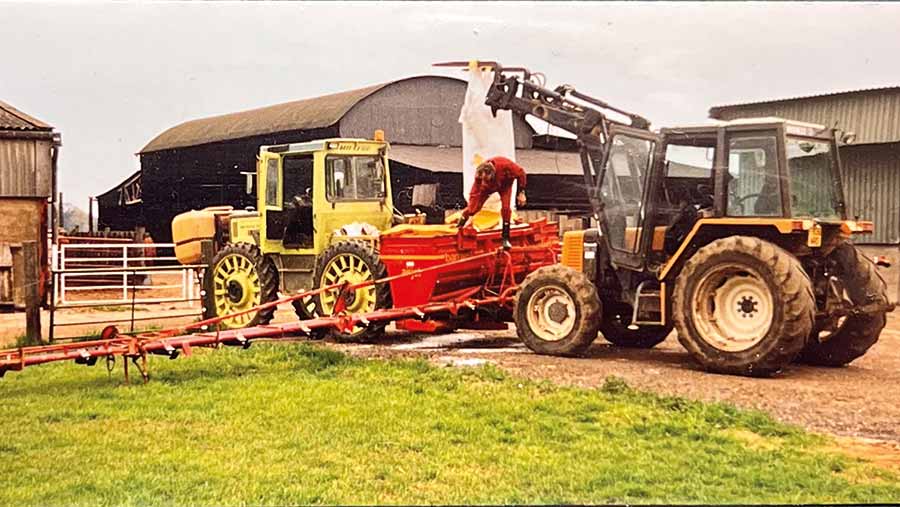
In the early years spraying and spreading were the job of an MB Trac © Harry Metcalfe
Since then, I’ve had a Massey 1200 with a turbo conversion, a Mercedes MB Trac and a few JCB Fastracs.
I’ve now got a Case IH tractor and combine, partly because I used to share an Axial Flow 2188 with another farmer, which I thought was a brilliant combine and such a simple, effective design.
Favourite dealer?
The Case IH kit comes from Cotswold Farm Machinery near Cheltenham, and the team there do a great job servicing it and fixing any problems we have.
I also use TH White for Manitou spares and servicing, which is a good firm to deal with.
Back in the Hertfordshire days, I used Browns Agricultural Machinery, and the people there were very helpful when I was starting out.
Favourite piece of kit?
I like all my machinery, but the Manitou is probably my favourite. I’d forgotten what an amazing piece of kit a telehandler is, and I can’t believe I managed without one for so long.
It’s a very tidy 2004 model that I bought second-hand, and it has a 4.1t lift capacity so I can use a big grain bucket for loading lorries.
The 7m boom is also handy for shunting grain around, particularly with the addition of a pusher.
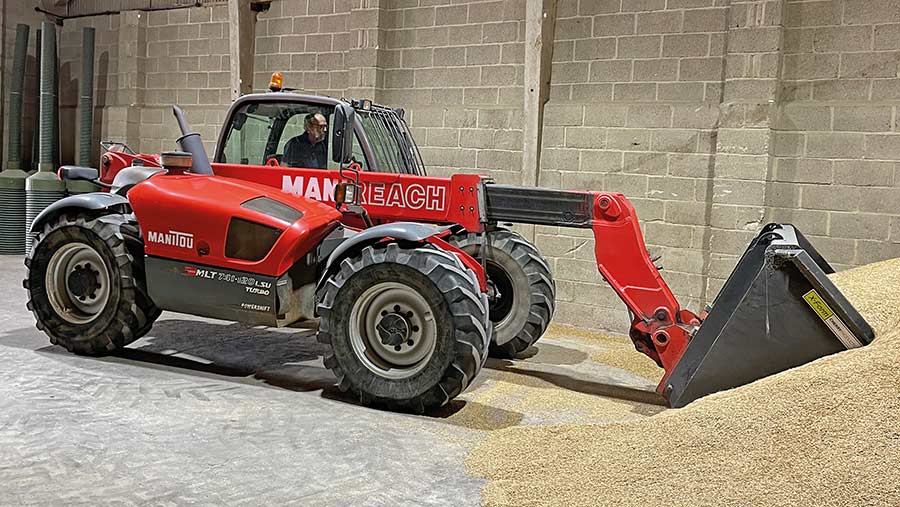
A tidy 2004 Manitou telehandler is used to load grain and sweep mud off the road © James Andrews
I hate getting mud on the road – or, more specifically, I hate driving my cars through it – so I’ve got a Suton brush, which also comes in handy for clearing out the grain store.
The Manitou’s only downside is that the ride on the road is horrendously rough.
Least favourite?
I’m not a fan of our Claydon straw rake as it doesn’t disturb enough soil for weed seeds to germinate effectively. I wish it did, as it’s 7.5m wide and I can cover the ground so quickly.
Instead, I bought a second-hand 5m Vaderstad Carrier for £10,000, which does a perfect job and gets the ground ready for John to plant with his Claydon Hybrid drill.
It’s a bit worn and needs a new set of discs, but it’s good enough to warrant the investment. Like all Vaderstad kit, it’s incredibly well made and the rest of it looks like it’ll last a lifetime.
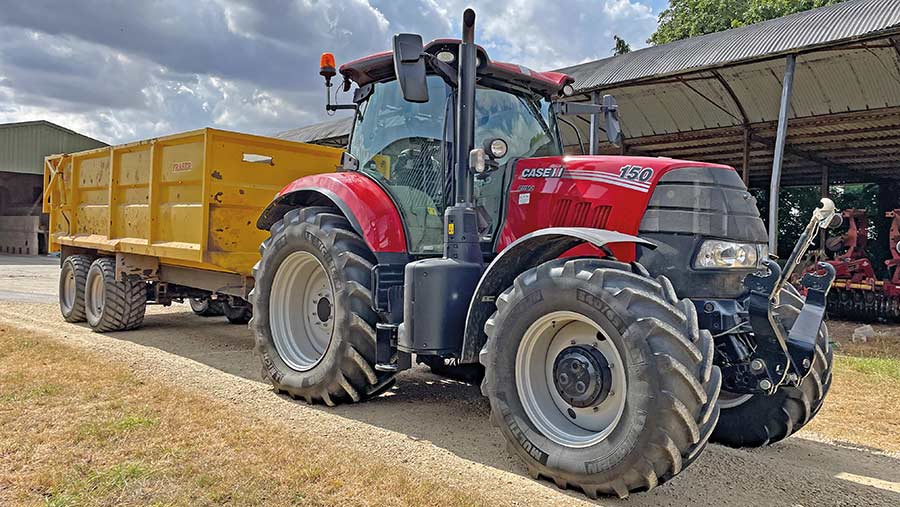
The Case IH Puma 150 arrived with 200 hours on the clock © James Andrews
Latest purchase?
Last year I bought a GPS autosteer system for the Case Puma 150, which was the icing on the cake for that tractor.
It’s transformed the cultivating job, helping me drive more accurately and making it more enjoyable – it was well worth the £7,000 outlay.
There are no ongoing fees either, as it’s on the free Egnos signal, which is plenty accurate enough.
I just wish manufacturers would build the receivers into the cab roof so they don’t get pinched.
Oldest machine still at work?
It’s currently the Renault tractor. But once that’s sold, it’ll be either the 2004 Manitou or the Vaderstad Carrier, as I’m not sure exactly how old that is. Both are still going strong.
How long do you keep your machines?
All the equipment I’ve got is more than adequate for the work it does, and there are no plans to change any of it soon.
I’ve also got no idea which way farming is going to go, so I don’t want to be spending lots of money on machinery right now.
What’s next on your wishlist?
If money was no object I’d like a combine on tracks, as I’m bored of the constant peril of flattening parked cars and pedestrians as I thread my way through the village.
Most embarrassing machinery mistake?
The hydraulic tailgate on the grain trailer wouldn’t shut properly, so I went out to investigate and somehow got my thumb trapped behind one of the stops.
There was no way I could move it but, thankfully, I’d had the foresight to bring an old bale spike from the cab, which was just within reach.
It gave enough leverage to prise my thumb free and I got away with some nasty bruising and a blackened nail.
Most expensive repair bill?
In the early days, I had a couple of JCB Fastrac 155-65s in succession which were brilliant.
I carried a 20m demount Airtec sprayer on them, spraying at 70 litres/acre, and the combination meant I could cover a large area very quickly.
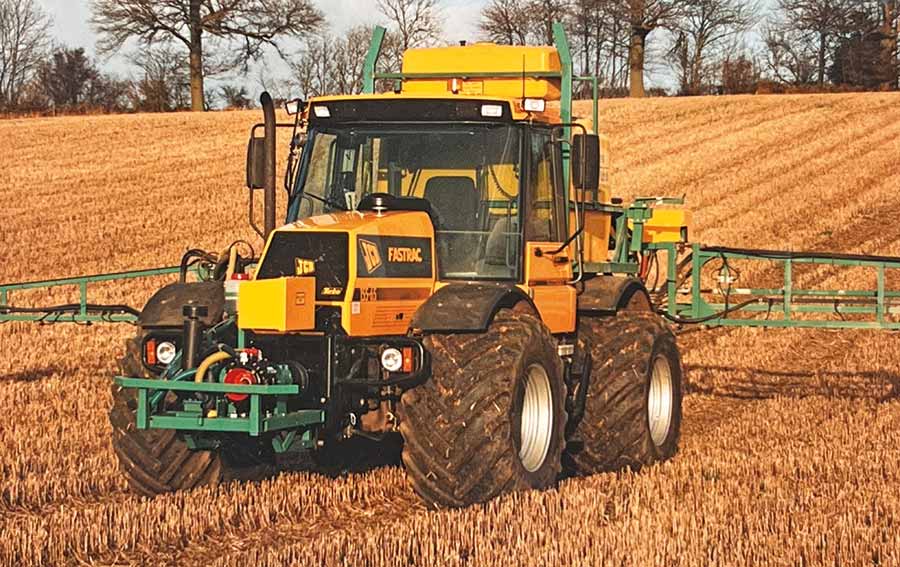
During his first stint in farming, Mr Metcalfe ran JCB Fastracs with a 20m demount Airtec sprayer © Harry Metcalfe
With my rose-tinted spectacles on, the first tractor I bought when I got back into farming was a Fastrac 2150. It was OK to drive, but it had done 8,000 hours and gave me no end of trouble.
The front diff went bang first, costing £2,500, and then I had to spend a further £6,000 fixing a series of problems.
I’d paid £18,000 for it and ended up selling it on eBay a few months later for £14,000.
Best invention?
It’s not my invention, but when I was running an MB Trac with a horrendous stock seat, I invested £800 in a plush aftermarket one with smooth sprung suspension.
It was so good that I kept it and used it in the JCB Fastrac 155-65s..
Do you buy second-hand?
We don’t have that much work to do, so all the machinery was bought second-hand. The Case Puma 150 is the newest and was only six months old with 200 hours on the clock when it arrived.
Favourite and least favourite jobs?
Rolling is my favourite as you’re adding the final polish to the job and signing off the season. Cleaning the combine is the most unpleasant.
I used to use a pressure washer but switched to blowing it off with a compressor as I was convinced the water had stuffed a few bearings. It’s horrible whichever way you do it.
Best tractor you’ve had?
The Puma 150 is just brilliant and it amazes me how much tractors have come on in the time I was away from farming.
They are so much more comfortable and user friendly; I think the car world could learn a thing or two from tractor cab design.
I bought it in 2018 and it cost £69,000, which seems like very good value given the current market. It’s only on 800 hours now, so barely run in.
The old MB Trac is also up there as it was such a forward-thinking design and was incredibly well made.
Worst tractor you’ve had?
That would be the JCB 2150, which I’m very glad to see the back of.
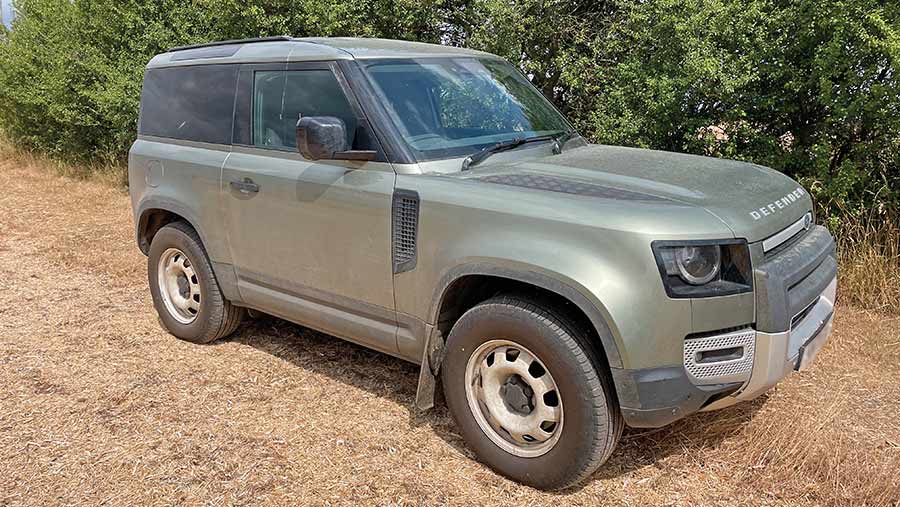
The Defender D200 on loan from Land Rover © James Andrews
What’s your everyday transport?
I’ve got a new Defender D200 on long-term test from Land Rover, which I like a lot more than I expected.
It’s great on long journeys, averaging about 35mpg, and performs well off-road, even though it has road tyres.
The downsides are that there’s precious little carrying capacity and it comes with a mandatory bulkhead, which just gets in the way.
It’s also got coil suspension, which gives a choppy ride, and I’d recommend anyone buying one to upgrade to the air system.
My own farm vehicle is a 2006 Range Rover L322 with a TD V8 engine that’s a cheap and very capable runaround.

